Factors Influencing Apple Inc. Growth in Developing Countries Research
VerifiedAdded on 2021/04/24
|7
|990
|57
Report
AI Summary
This research report examines the factors influencing the growth of Apple Inc. in developing countries. It identifies the topic as management, focusing on the challenges and opportunities Apple faces in expanding its market share. The problem statement highlights political and environmental constraints that increase product costs, potentially limiting sales in developing nations. The research aims to understand the possibilities and limitations for Apple in these markets, with objectives including examining sales-boosting situations and identifying manufacturing unit setup restrictions. The methodology employs a qualitative approach, using interviews for primary data collection, supplemented by secondary data from scholarly sources and Apple's official website. Data will be analyzed thematically, ensuring ethical considerations such as data integrity and unbiased interpretation. The conclusion emphasizes the importance of addressing trade and environmental policy constraints for Apple's growth in developing countries.
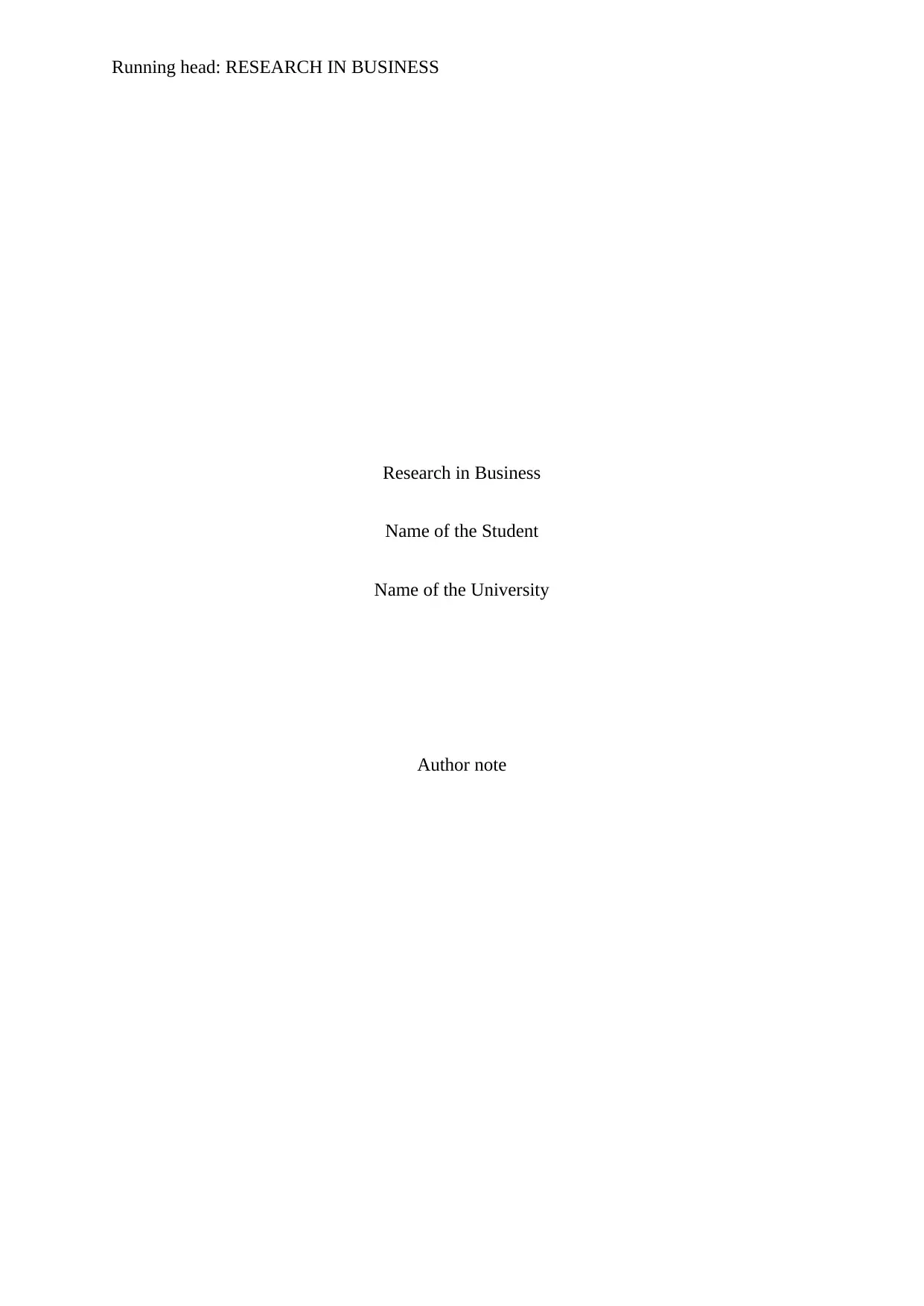
Running head: RESEARCH IN BUSINESS
Research in Business
Name of the Student
Name of the University
Author note
Research in Business
Name of the Student
Name of the University
Author note
Paraphrase This Document
Need a fresh take? Get an instant paraphrase of this document with our AI Paraphraser
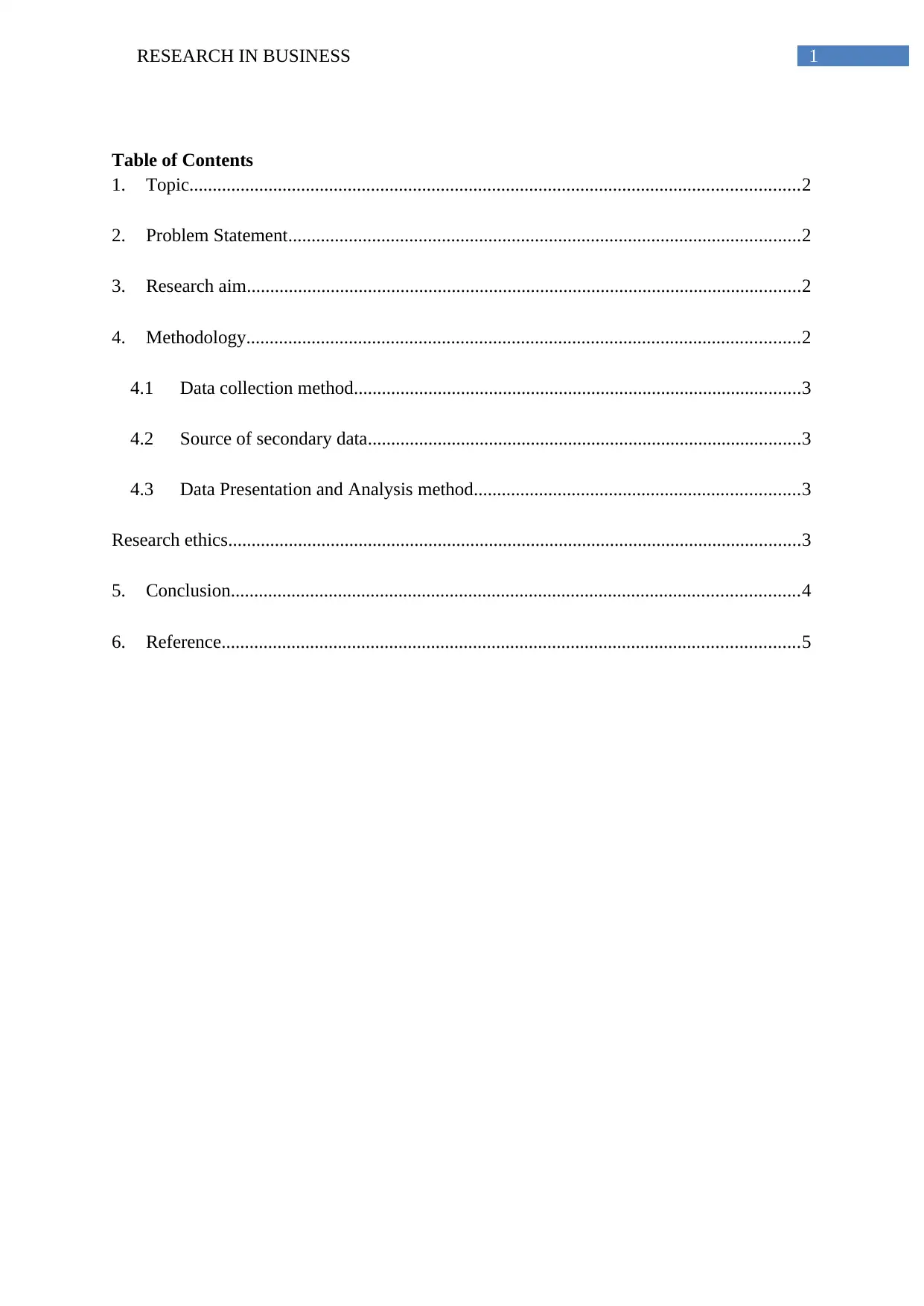
1RESEARCH IN BUSINESS
Table of Contents
1. Topic...................................................................................................................................2
2. Problem Statement..............................................................................................................2
3. Research aim.......................................................................................................................2
4. Methodology.......................................................................................................................2
4.1 Data collection method................................................................................................3
4.2 Source of secondary data.............................................................................................3
4.3 Data Presentation and Analysis method......................................................................3
Research ethics...........................................................................................................................3
5. Conclusion..........................................................................................................................4
6. Reference............................................................................................................................5
Table of Contents
1. Topic...................................................................................................................................2
2. Problem Statement..............................................................................................................2
3. Research aim.......................................................................................................................2
4. Methodology.......................................................................................................................2
4.1 Data collection method................................................................................................3
4.2 Source of secondary data.............................................................................................3
4.3 Data Presentation and Analysis method......................................................................3
Research ethics...........................................................................................................................3
5. Conclusion..........................................................................................................................4
6. Reference............................................................................................................................5
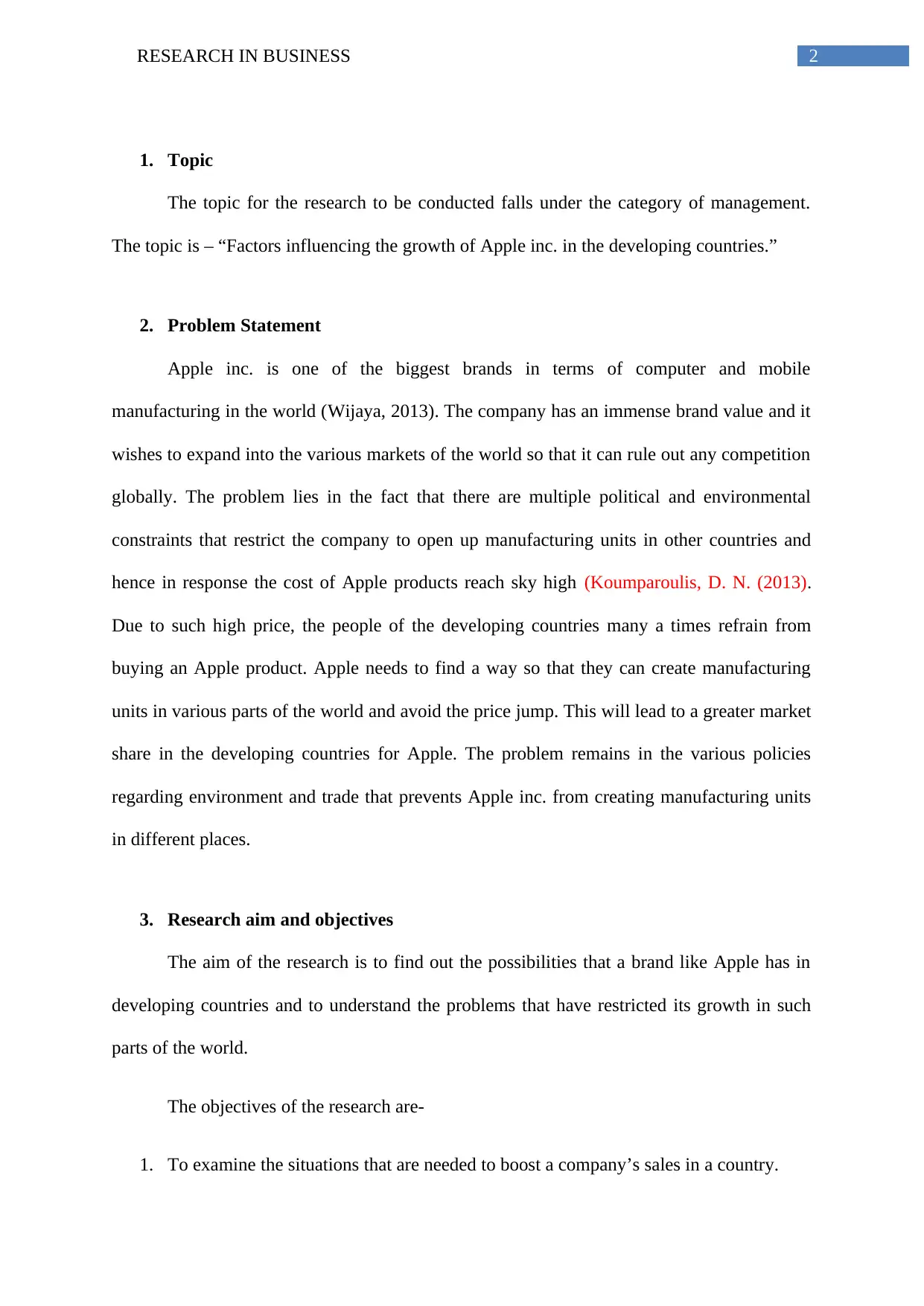
2RESEARCH IN BUSINESS
1. Topic
The topic for the research to be conducted falls under the category of management.
The topic is – “Factors influencing the growth of Apple inc. in the developing countries.”
2. Problem Statement
Apple inc. is one of the biggest brands in terms of computer and mobile
manufacturing in the world (Wijaya, 2013). The company has an immense brand value and it
wishes to expand into the various markets of the world so that it can rule out any competition
globally. The problem lies in the fact that there are multiple political and environmental
constraints that restrict the company to open up manufacturing units in other countries and
hence in response the cost of Apple products reach sky high (Koumparoulis, D. N. (2013).
Due to such high price, the people of the developing countries many a times refrain from
buying an Apple product. Apple needs to find a way so that they can create manufacturing
units in various parts of the world and avoid the price jump. This will lead to a greater market
share in the developing countries for Apple. The problem remains in the various policies
regarding environment and trade that prevents Apple inc. from creating manufacturing units
in different places.
3. Research aim and objectives
The aim of the research is to find out the possibilities that a brand like Apple has in
developing countries and to understand the problems that have restricted its growth in such
parts of the world.
The objectives of the research are-
1. To examine the situations that are needed to boost a company’s sales in a country.
1. Topic
The topic for the research to be conducted falls under the category of management.
The topic is – “Factors influencing the growth of Apple inc. in the developing countries.”
2. Problem Statement
Apple inc. is one of the biggest brands in terms of computer and mobile
manufacturing in the world (Wijaya, 2013). The company has an immense brand value and it
wishes to expand into the various markets of the world so that it can rule out any competition
globally. The problem lies in the fact that there are multiple political and environmental
constraints that restrict the company to open up manufacturing units in other countries and
hence in response the cost of Apple products reach sky high (Koumparoulis, D. N. (2013).
Due to such high price, the people of the developing countries many a times refrain from
buying an Apple product. Apple needs to find a way so that they can create manufacturing
units in various parts of the world and avoid the price jump. This will lead to a greater market
share in the developing countries for Apple. The problem remains in the various policies
regarding environment and trade that prevents Apple inc. from creating manufacturing units
in different places.
3. Research aim and objectives
The aim of the research is to find out the possibilities that a brand like Apple has in
developing countries and to understand the problems that have restricted its growth in such
parts of the world.
The objectives of the research are-
1. To examine the situations that are needed to boost a company’s sales in a country.
⊘ This is a preview!⊘
Do you want full access?
Subscribe today to unlock all pages.

Trusted by 1+ million students worldwide
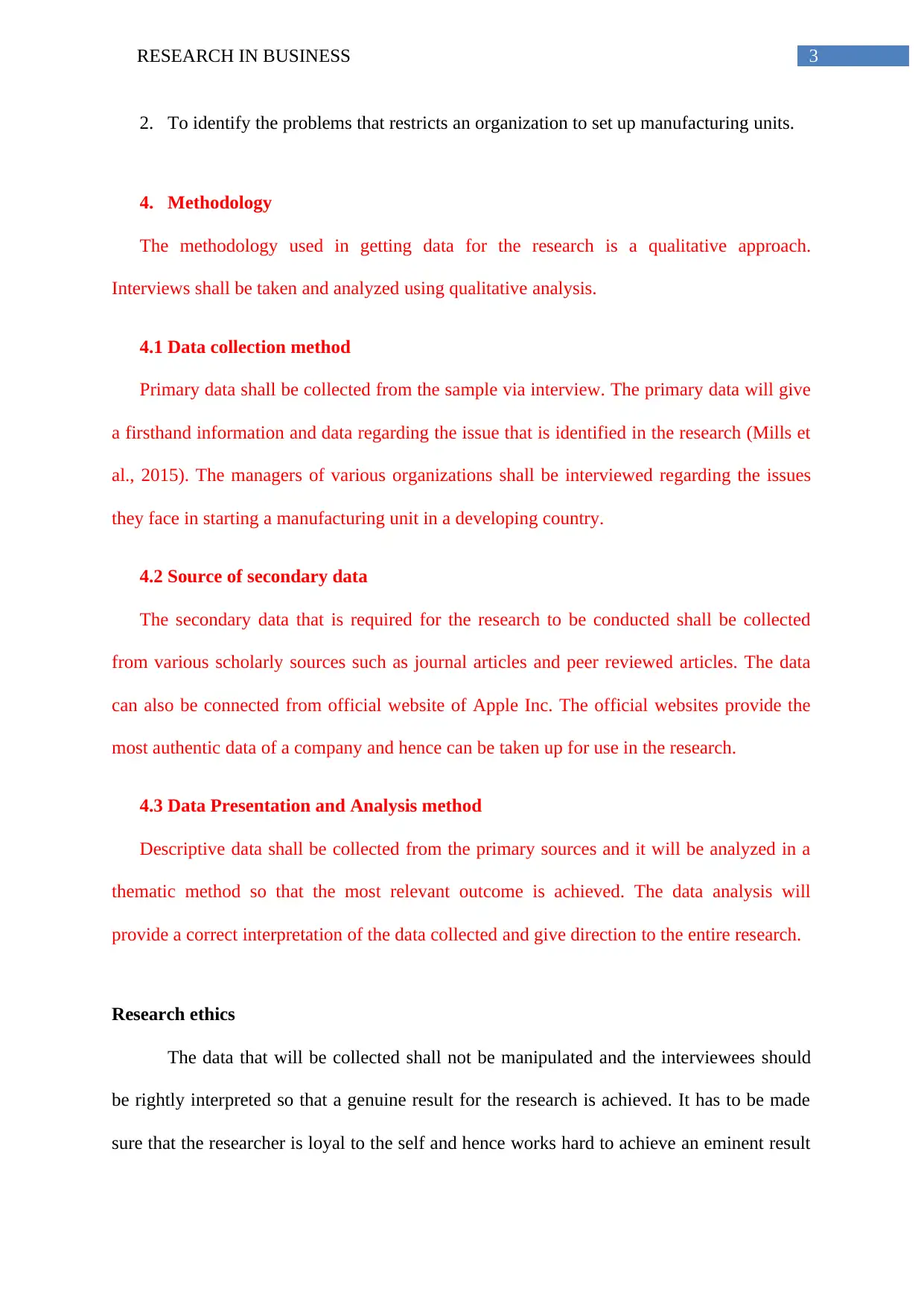
3RESEARCH IN BUSINESS
2. To identify the problems that restricts an organization to set up manufacturing units.
4. Methodology
The methodology used in getting data for the research is a qualitative approach.
Interviews shall be taken and analyzed using qualitative analysis.
4.1 Data collection method
Primary data shall be collected from the sample via interview. The primary data will give
a firsthand information and data regarding the issue that is identified in the research (Mills et
al., 2015). The managers of various organizations shall be interviewed regarding the issues
they face in starting a manufacturing unit in a developing country.
4.2 Source of secondary data
The secondary data that is required for the research to be conducted shall be collected
from various scholarly sources such as journal articles and peer reviewed articles. The data
can also be connected from official website of Apple Inc. The official websites provide the
most authentic data of a company and hence can be taken up for use in the research.
4.3 Data Presentation and Analysis method
Descriptive data shall be collected from the primary sources and it will be analyzed in a
thematic method so that the most relevant outcome is achieved. The data analysis will
provide a correct interpretation of the data collected and give direction to the entire research.
Research ethics
The data that will be collected shall not be manipulated and the interviewees should
be rightly interpreted so that a genuine result for the research is achieved. It has to be made
sure that the researcher is loyal to the self and hence works hard to achieve an eminent result
2. To identify the problems that restricts an organization to set up manufacturing units.
4. Methodology
The methodology used in getting data for the research is a qualitative approach.
Interviews shall be taken and analyzed using qualitative analysis.
4.1 Data collection method
Primary data shall be collected from the sample via interview. The primary data will give
a firsthand information and data regarding the issue that is identified in the research (Mills et
al., 2015). The managers of various organizations shall be interviewed regarding the issues
they face in starting a manufacturing unit in a developing country.
4.2 Source of secondary data
The secondary data that is required for the research to be conducted shall be collected
from various scholarly sources such as journal articles and peer reviewed articles. The data
can also be connected from official website of Apple Inc. The official websites provide the
most authentic data of a company and hence can be taken up for use in the research.
4.3 Data Presentation and Analysis method
Descriptive data shall be collected from the primary sources and it will be analyzed in a
thematic method so that the most relevant outcome is achieved. The data analysis will
provide a correct interpretation of the data collected and give direction to the entire research.
Research ethics
The data that will be collected shall not be manipulated and the interviewees should
be rightly interpreted so that a genuine result for the research is achieved. It has to be made
sure that the researcher is loyal to the self and hence works hard to achieve an eminent result
Paraphrase This Document
Need a fresh take? Get an instant paraphrase of this document with our AI Paraphraser
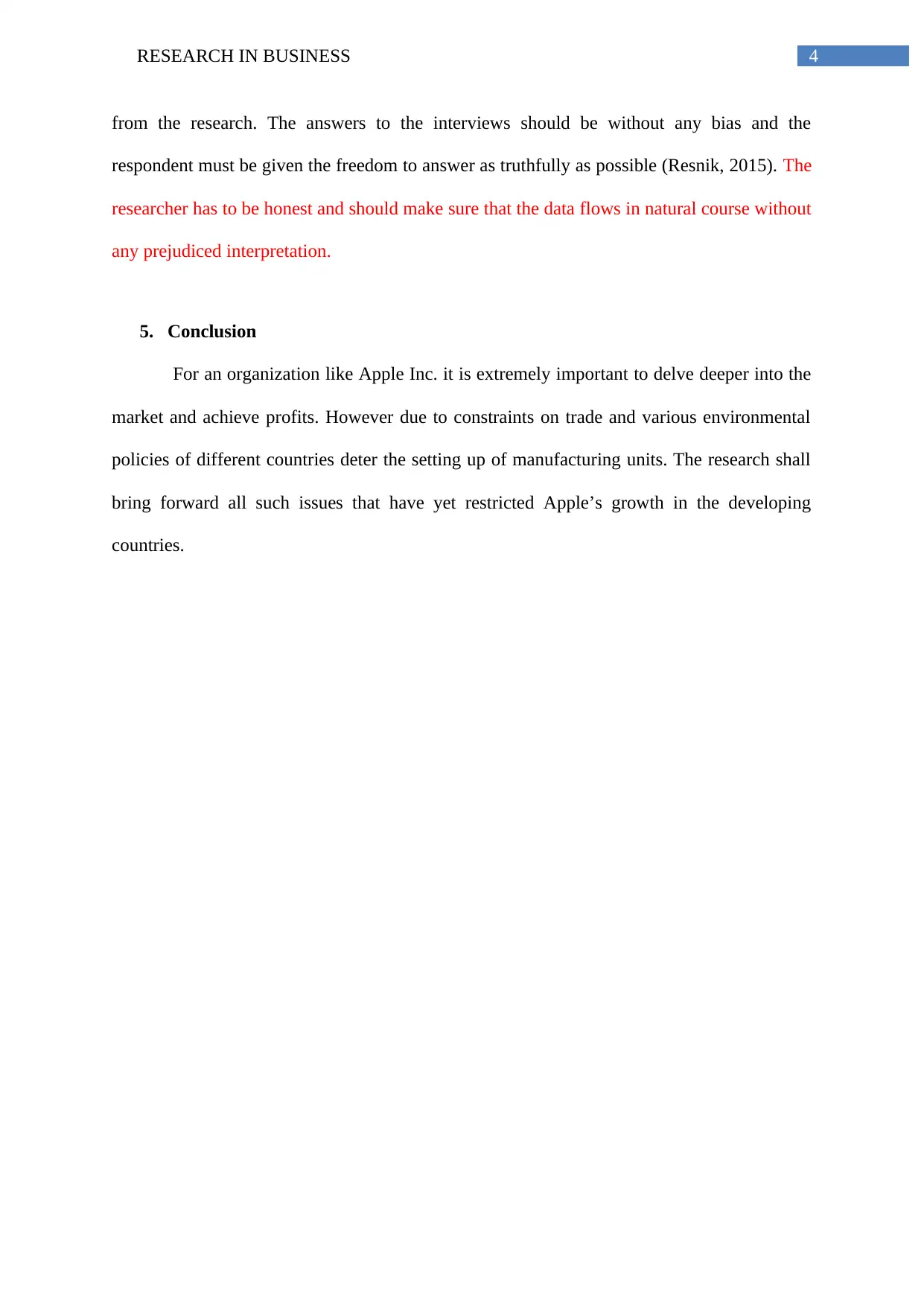
4RESEARCH IN BUSINESS
from the research. The answers to the interviews should be without any bias and the
respondent must be given the freedom to answer as truthfully as possible (Resnik, 2015). The
researcher has to be honest and should make sure that the data flows in natural course without
any prejudiced interpretation.
5. Conclusion
For an organization like Apple Inc. it is extremely important to delve deeper into the
market and achieve profits. However due to constraints on trade and various environmental
policies of different countries deter the setting up of manufacturing units. The research shall
bring forward all such issues that have yet restricted Apple’s growth in the developing
countries.
from the research. The answers to the interviews should be without any bias and the
respondent must be given the freedom to answer as truthfully as possible (Resnik, 2015). The
researcher has to be honest and should make sure that the data flows in natural course without
any prejudiced interpretation.
5. Conclusion
For an organization like Apple Inc. it is extremely important to delve deeper into the
market and achieve profits. However due to constraints on trade and various environmental
policies of different countries deter the setting up of manufacturing units. The research shall
bring forward all such issues that have yet restricted Apple’s growth in the developing
countries.
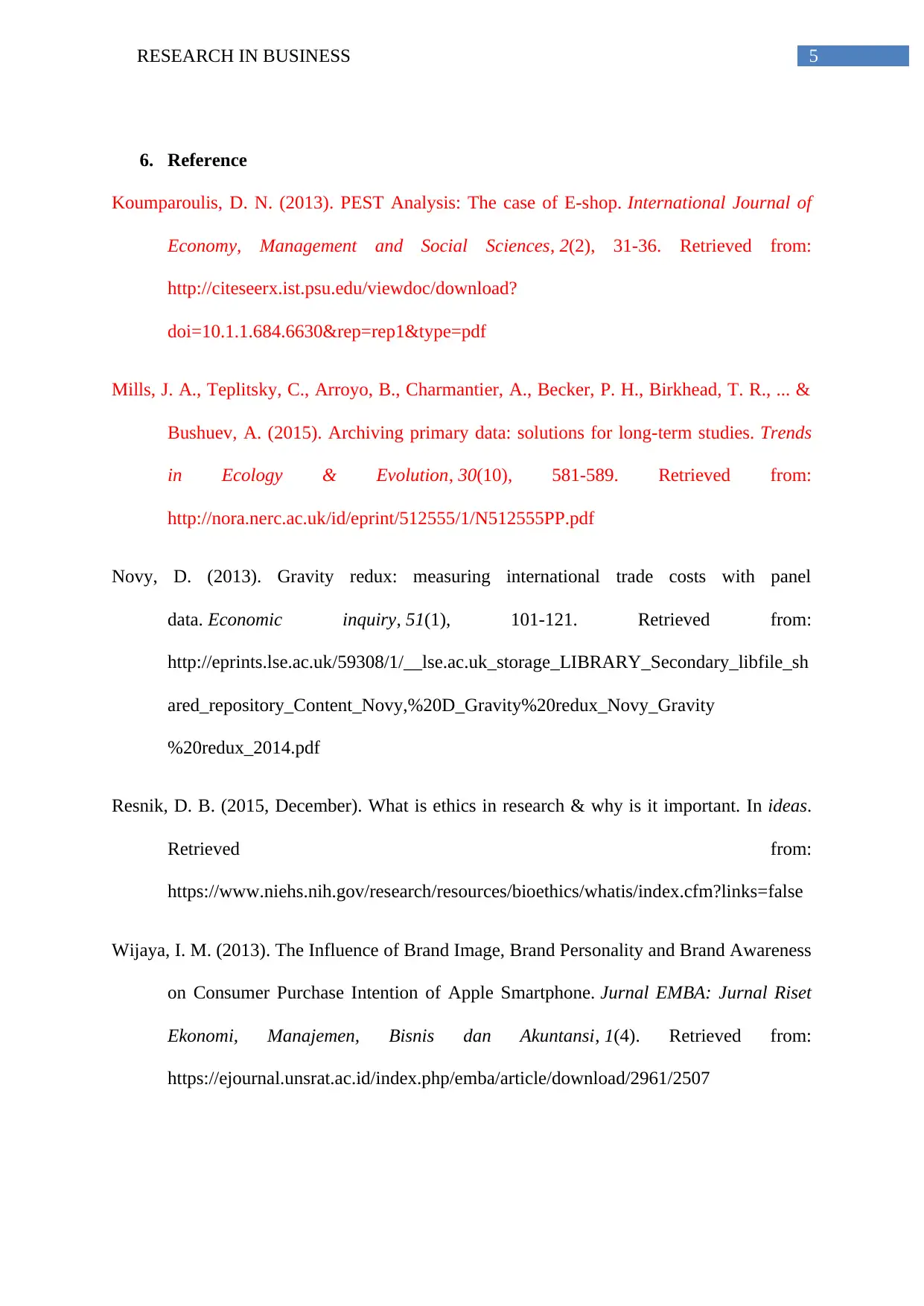
5RESEARCH IN BUSINESS
6. Reference
Koumparoulis, D. N. (2013). PEST Analysis: The case of E-shop. International Journal of
Economy, Management and Social Sciences, 2(2), 31-36. Retrieved from:
http://citeseerx.ist.psu.edu/viewdoc/download?
doi=10.1.1.684.6630&rep=rep1&type=pdf
Mills, J. A., Teplitsky, C., Arroyo, B., Charmantier, A., Becker, P. H., Birkhead, T. R., ... &
Bushuev, A. (2015). Archiving primary data: solutions for long-term studies. Trends
in Ecology & Evolution, 30(10), 581-589. Retrieved from:
http://nora.nerc.ac.uk/id/eprint/512555/1/N512555PP.pdf
Novy, D. (2013). Gravity redux: measuring international trade costs with panel
data. Economic inquiry, 51(1), 101-121. Retrieved from:
http://eprints.lse.ac.uk/59308/1/__lse.ac.uk_storage_LIBRARY_Secondary_libfile_sh
ared_repository_Content_Novy,%20D_Gravity%20redux_Novy_Gravity
%20redux_2014.pdf
Resnik, D. B. (2015, December). What is ethics in research & why is it important. In ideas.
Retrieved from:
https://www.niehs.nih.gov/research/resources/bioethics/whatis/index.cfm?links=false
Wijaya, I. M. (2013). The Influence of Brand Image, Brand Personality and Brand Awareness
on Consumer Purchase Intention of Apple Smartphone. Jurnal EMBA: Jurnal Riset
Ekonomi, Manajemen, Bisnis dan Akuntansi, 1(4). Retrieved from:
https://ejournal.unsrat.ac.id/index.php/emba/article/download/2961/2507
6. Reference
Koumparoulis, D. N. (2013). PEST Analysis: The case of E-shop. International Journal of
Economy, Management and Social Sciences, 2(2), 31-36. Retrieved from:
http://citeseerx.ist.psu.edu/viewdoc/download?
doi=10.1.1.684.6630&rep=rep1&type=pdf
Mills, J. A., Teplitsky, C., Arroyo, B., Charmantier, A., Becker, P. H., Birkhead, T. R., ... &
Bushuev, A. (2015). Archiving primary data: solutions for long-term studies. Trends
in Ecology & Evolution, 30(10), 581-589. Retrieved from:
http://nora.nerc.ac.uk/id/eprint/512555/1/N512555PP.pdf
Novy, D. (2013). Gravity redux: measuring international trade costs with panel
data. Economic inquiry, 51(1), 101-121. Retrieved from:
http://eprints.lse.ac.uk/59308/1/__lse.ac.uk_storage_LIBRARY_Secondary_libfile_sh
ared_repository_Content_Novy,%20D_Gravity%20redux_Novy_Gravity
%20redux_2014.pdf
Resnik, D. B. (2015, December). What is ethics in research & why is it important. In ideas.
Retrieved from:
https://www.niehs.nih.gov/research/resources/bioethics/whatis/index.cfm?links=false
Wijaya, I. M. (2013). The Influence of Brand Image, Brand Personality and Brand Awareness
on Consumer Purchase Intention of Apple Smartphone. Jurnal EMBA: Jurnal Riset
Ekonomi, Manajemen, Bisnis dan Akuntansi, 1(4). Retrieved from:
https://ejournal.unsrat.ac.id/index.php/emba/article/download/2961/2507
⊘ This is a preview!⊘
Do you want full access?
Subscribe today to unlock all pages.

Trusted by 1+ million students worldwide

6RESEARCH IN BUSINESS
1 out of 7
Related Documents
Your All-in-One AI-Powered Toolkit for Academic Success.
+13062052269
info@desklib.com
Available 24*7 on WhatsApp / Email
![[object Object]](/_next/static/media/star-bottom.7253800d.svg)
Unlock your academic potential
Copyright © 2020–2025 A2Z Services. All Rights Reserved. Developed and managed by ZUCOL.



